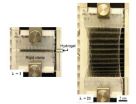Call for a new approach to fighting tuberculosis
Provocative NEJM essay calls for redoubling of efforts
2012-09-06
(Press-News.org) Boston, MA – Each year, nearly 2 million people die from tuberculosis – a treatable disease that has been brought under control in the United States, but continues to ravage other parts of the world. This health inequity should prompt a complete rethinking of the way tuberculosis is fought on a global level, argue Salmaan Keshavjee, MD, PhD, and Paul Farmer, MD, PhD, from Brigham and Women's Hospital (BWH). Their argument appears in an essay published September 6 in the New England Journal of Medicine.
"The global approach to fighting tuberculosis has been lacking," says Dr. Keshavjee, a physician in the Division Global Health Equity at BWH. "For too long we've accepted a divergence in the standard of care between people living in the rich world and those suffering from this disease elsewhere."
"The history of tuberculosis is in many ways the history of modern medicine; the history of drug-resistant tuberculosis is the history of most infectious diseases for which we've developed effective antibiotics," says Dr. Farmer, the chief of the Division of Global Health Equity at BWH. "As an airborne infection, tuberculosis has always challenged confident policy recommendations, and we seek to review these here."
Treatment protocols for multi-drug resistant tuberculosis have been known for decades; however, barely 0.5 percent of all newly diagnosed patients worldwide receive treatment that is the standard of care in the United States. Even among groups known to face a high risk of mortality from tuberculosis—such as children and people living with HIV—few patients have received appropriate treatment. According to the authors, this lack of treatment only fuels the pandemic since tuberculosis is transmitted through the air.
The authors also cite a lack of resources to combat the disease, arguing that investments to cure infected patients and efforts to stem the spread of tuberculosis pale in comparison to the amount of resources and energy dedicated globally to the AIDS epidemic.
In this article, written in commemoration of the New England Journal of Medicine's 200th Anniversary, Drs. Keshavjee and Farmer explore the reasons why scientific knowledge about tuberculosis is not reflected in current global tuberculosis policy. For Dr. Keshavjee, understanding the construction of current policy is a critical part of moving forward. "We want to encourage the international tuberculosis community to redouble its efforts to battle this disease, including adopting a goal of zero tuberculosis deaths," said Dr. Keshavjee. "That means proactively looking for those who are already sick, ensuring they are rapidly diagnosed and putting them on appropriate treatment. It also means treating those with latent infection and implementing infection control measures that can stop the spread of the disease. This is the approach we've used in the United States and Western Europe, and it needs to become the global standard of care." The authors also note that an equity plan—one that addresses poverty, malnutrition, and over-crowded living and working conditions—has to be part of the solution.
"We've had the good fortune of working together on this problem, as clinicians and as policymakers and as researchers, for 15 years," said Dr. Farmer. "We hope this critical review will prove helpful in rethinking the history of this disease and of other chronic infections, including HIV disease, for which treatments have been developed. All such pathogens—bacterial, viral, parasitic—undergo mutations when challenged with antibiotics; many are public health threats."
"This review is one step in understanding how efforts to combat tuberculosis arrived at its present state," adds Dr. Keshavjee. "Our hope is that it will contribute to the conversation about the ways in which our global community can better prevent deaths from this treatable disease."
INFORMATION:
END
ELSE PRESS RELEASES FROM THIS DATE:
2012-09-06
ENCODE, an international research project led by the National Human Genome Research Institute (NHGRI), has produced and analyzed 1649 data sets designed to annotate functional elements of the entire human genome. Data on transcription starting sites (TSS) contributed by a research team at the RIKEN Omics Science Center provided key anchor points linking the epigenetic status of genes observed at the 5' end directly to their RNA output.
The ENCODE (Encyclopedia of DNA Elements) project aims to delineate all functional elements encoded in the human genome. Thirty-two institutes ...
2012-09-06
This press release is available in German.
Physicists at the University of Vienna and the Austrian Academy of Sciences have achieved quantum teleportation over a record distance of 143 km. The experiment is a major step towards satellite-based quantum communication. The results have now been published in "Nature" (Advance Online Publication/AOP).
An international team led by the Austrian physicist Anton Zeilinger has successfully transmitted quantum states between the two Canary Islands of La Palma and Tenerife, over a distance of 143 km. The previous record, set ...
2012-09-06
Cambridge, Mass. - September 5, 2012 - A team of experts in mechanics, materials science, and tissue engineering at Harvard have created an extremely stretchy and tough gel that may pave the way to replacing damaged cartilage in human joints.
Called a hydrogel, because its main ingredient is water, the new material is a hybrid of two weak gels that combine to create something much stronger. Not only can this new gel stretch to 21 times its original length, but it is also exceptionally tough, self-healing, and biocompatible—a valuable collection of attributes that opens ...
2012-09-06
Genome Research publishes online and in print today a special issue dedicated to The ENCODE (ENCyclopedia Of DNA Elements) Project, whose goal is to characterize all functional elements in the human genome. Since the completion of the pilot phase of the project in 2007, covering 1% of the genome, The ENCODE Consortium has fanned out across the genome to study function and regulation on an unprecedented scale. This special issue presents novel findings, methodologies, and resources from ENCODE that bring extensive insight to gene regulation and set the stage for future ...
2012-09-06
(Boston) – Results of a study led by researchers at Boston University School of Medicine (BUSM) and the Veterans Affairs (VA) Boston Healthcare System indicate that the proposed changes to the diagnosis of post-traumatic stress disorder (PTSD) will not substantially affect the number of people who meet criteria for the disorder.
Mark W. Miller, PhD, associate professor at BUSM and a clinical research psychologist at the National Center for PTSD at VA Boston Healthcare System served as lead author of the study, which is published online in Psychological Trauma: Theory, ...
2012-09-06
Windows to the past, stars can unveil the history of our universe, currently estimated to be 14 billion years old. The farther away the star, the older it is — and the oldest stars are the most difficult to detect. Current telescopes can only see galaxies about 700 million years old, and only when the galaxy is unusually large or as the result of a big event like a stellar explosion.
Now, an international team of scientists led by researchers at Tel Aviv University have developed a method for detecting galaxies of stars that formed when the universe was in its infancy, ...
2012-09-06
Scientists have completed a comprehensive map of genetic mutations linked to an aggressive and lethal type of lung cancer.
Among the errors found in small cell lung cancers, the team of scientists, including those at the Johns Hopkins Kimmel Cancer Center, found an alteration in a gene called SOX2 associated with early embryonic development.
"Small cell lung cancers are very aggressive. Most are found late, when the cancer has spread and typical survival is less than a year after diagnosis," says Charles Rudin, M.D., Ph.D., professor of oncology at the Johns Hopkins ...
2012-09-06
ANN ARBOR, Mich. — Aiming to cut expenses and improve care, a 2008 Medicare policy stopped paying hospitals extra to treat some preventable, hospital-acquired conditions – including urinary tract infections (UTIs) in patients after bladder catheters are placed.
But a statewide analysis by the University of Michigan shows there was very little change in hospital payment due to removing pay for hospital-acquired catheter-associated UTIs. For all adult hospital stays in Michigan in 2009, eliminating payment for this infection decreased hospital pay for only 25 hospital ...
2012-09-06
RICHLAND, Wash. – Today's light-emitting diode light bulbs have a slight environmental edge over compact fluorescent lamps. And that gap is expected to grow significantly as technology and manufacturing methods improve in the next five years, according to a new report from the Department of Energy's Pacific Northwest National Laboratory and UK-based N14 Energy Limited.
"The light-emitting diode lamp is a rapidly evolving technology that, while already energy efficient, will become even more so in just a few short years," said Marc Ledbetter, who manages PNNL's solid-state ...
2012-09-06
ANN ARBOR, Mich.—The rhetoric is relentless: America is a place of unparalleled opportunity, where hard work and determination can propel a child out of humble beginnings into the White House, or at least a mansion on a hill.
But the reality is very different, according to a University of Michigan researcher who is studying inequality across generations around the world.
"Especially in the United States, people underestimate the extent to which your destiny is linked to your background. Research shows that it's really a myth that the U.S. is a land of exceptional social ...
LAST 30 PRESS RELEASES:
[Press-News.org] Call for a new approach to fighting tuberculosis
Provocative NEJM essay calls for redoubling of efforts




